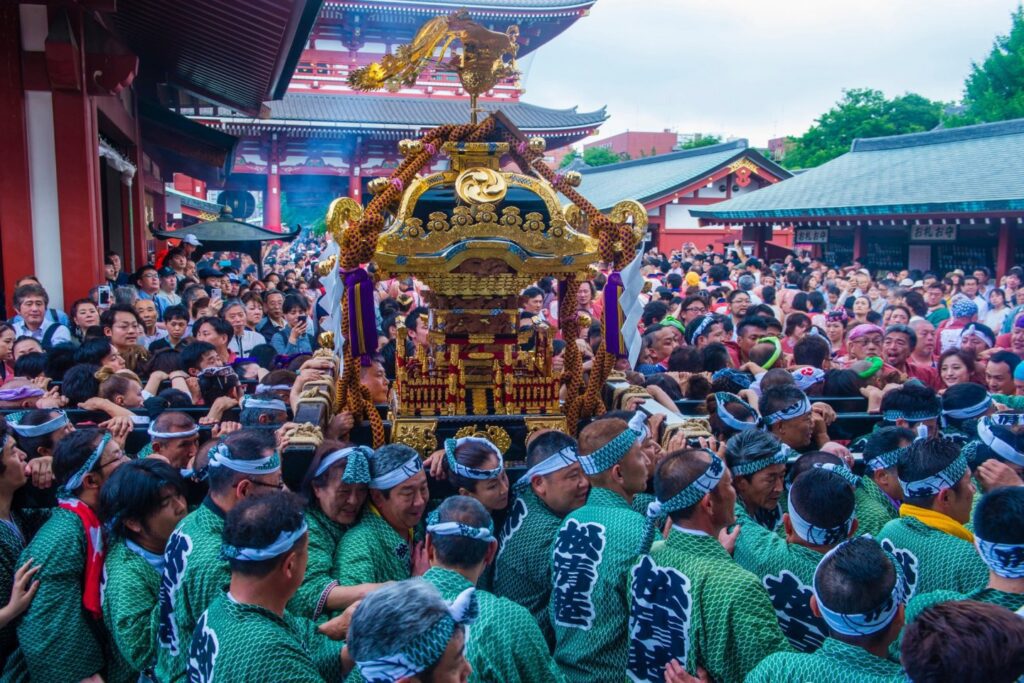Traditional Japanese Matsuri festivals offer a vibrant cultural experience, reflecting the local customs, beliefs, and culture. Deriving from the word “Matsuru,” which means to worship or revere, these festivals vary from solemn rituals to lively parades. Well-known festivals such as Sanja Matsuri, Gion Matsuri, and Nebuta Matsuri captivate audiences with decorated floats, energetic performances, and spiritual ceremonies. Visitors can deepen their understanding of the festivals’ history, rituals, and legends and engage with the Japanese community’s spirit and exuberance. A guide to these festivities often provides invaluable cultural insights. These festivals showcase unity, tradition, and the zealous Japanese spirit.
Explore Japanese Culture through its Famous Matsuri Festivals
Japan – a land known for its fusion of uber-modern technology, millennia-old traditions, and enchanting landscapes – holds an allure that inevitably captivates its visitors. But beyond the iconic concrete forest of Tokyo, the tranquil temples of Kyoto, and the snow-capped peaks of Mount Fuji, lies a vibrant cultural phenomena that warrants exploration – the Japanese Matsuri festivals.
What is a Matsuri Festival?
Derived from the word “Matsuru,” meaning to worship or revere, Matsuri Festivals are traditional Japanese celebrations held by local shrines and temples. Rich in spiritual significance, these festivals range from solemn rituals to lively parades. Each Matsuri festival is unique, reflecting the local culture, beliefs, and customs of its locale, offering visitors an immersive, authentic insight into the fabric of Japanese society.
The Fascinating Allure of Matsuri Festivals
Whether it’s extravagant processions of heavily decorated floats, energetic dance performances, or the quiet spiritual undertones of a temple ceremony, each Matsuri festival brims with color, vibrancy and an infectious energy that’s impossible to resist.
Sanja Matsuri
Held annually in May in Tokyo’s Asakusa district, Sanja Matsuri is one of Japan’s most lively and popular festivals. It’s best known for the boisterous procession of portable shrines (mikoshi), accompanied by music, dancing, and revelry. The weekend-long festivities provide an excellent opportunity for visitors to witness a significant facet of traditional Japanese culture.
Gion Matsuri
Occupying the entire month of July, Gion Matsuri in Kyoto is among Japan’s most famous festivals. This event is highlighted by its grand procession of floats – an array of intricately decorated yamaboko that are pulled through the city streets by teams of locals. The festival, with roots dating back to the 9th century, offers an exquisite spectacle of Japanese craftsmanship and communal spirit.
Nebuta Matsuri
Held in Aomori Prefecture’s capital city, Nebuta Matsuri is a visual feast of enormous lantern floats. These floats, depicting Japanese warriors, gods, and mythical creatures, hold a mesmerizing parade through the city in early August. This festival is a testament to the Japanese love of spectacle and artistry.
Dive Deeper in Matsuri Culture
While witnessing the Matsuri festivities, you will undoubtedly experience the Japanese community’s collective spirit and exuberance. However, understanding the histories, rituals, and legends behind each Matsuri Festival will make your experience richer.
To best appreciate the Matsuri festivals, consider guided tours that offer cultural insights, book accommodations ahead of time due to the popularity of these events, and most importantly, engage with locals – their personal narratives often offer the most enriching stories!
Conclusion
The Matsuri festivals are not just events – they are celebrations of unity, tradition, and the indefatigable Japanese spirit. Each festival, with its unique charm and character, offers a fascinating glimpse into the depths of Japanese culture. So, immerse yourself, participate, and be swept away by the whirlwind of excitement that the Matsuri festivals bring.
